Fitbit Charge 2 Review - Activity tracking Review
Activity tracking
A fitness tracker that teaches you to breathe
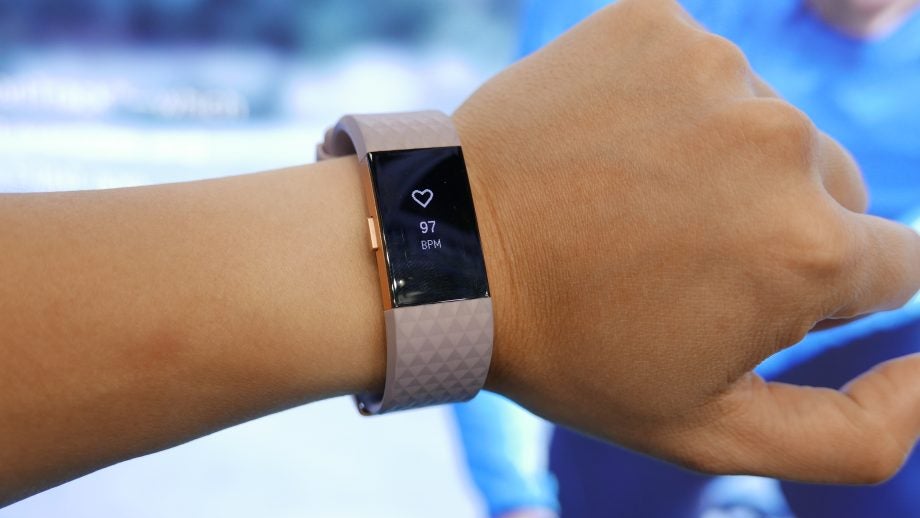
Sections
- Page 1 Fitbit Charge 2 Review
- Page 2 Activity tracking Review
- Page 3 App, battery life & verdict Review
Fitbit Charge 2 – Activity Tracking
As you’d expect, the Charge 2 has the usual all-day activity and sleep tracking with silent alarm. Slightly disappointingly, it isn’t a smart alarm that can wake you up at a more optimal time. The Charge 2 can begin automatically tracking selected sports and exercises such as hiking, cycling and, of course, running. Otherwise, you can trigger these from the button on the side.
Without the waterproofing seen on the new Flex 2, swimming is a no-go – which is a shame. There’s also no built-in GPS, but if you do go for a run with your smartphone paired, the Charge 2 can use connected GPS for tracking distance and routes. You don’t need to trigger the run from the app, either. Just start running and it will track in the background, or use the Charge 2 to manually start the run if you want running metrics on the display. GPS information will automatically get pulled in.
Related: Best fitness trackers
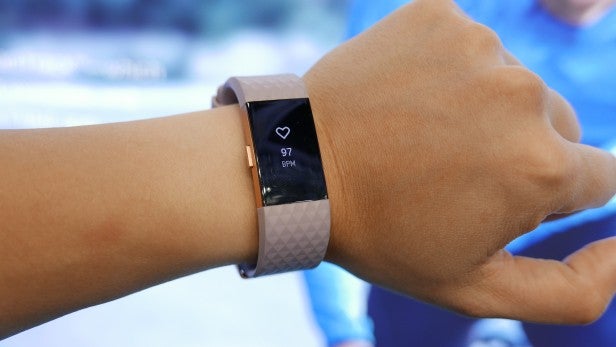
I took the Charge 2 for a number of test runs, including running the same route back-to-back – once with connected GPS and once without. The real surprise was the margin of error between the results. The first GPS-connected route was recorded at 2.64km, while the run sans smartphone came up at 2.65km. That was impressive considering accelerometer-based tracking can be significantly off the mark.
However, distance even with the connected GPS seemed to sell me short. I’ve run this route a number of times before using Strava and the GPS in my Huawei P9, and it’s typically recorded at around 2.85 to 2.9km. This distance was confirmed by the GPS built into the TomTom Spark 3 I wore simultaneously, which measured each run at around 2.9km.
As an aside, a Jawbone UP3 I wore put both runs at a combined 5.79km distance – unfortunately, it didn’t split the two laps. As I literally sat on my doorstep sweating profusely between the two runs, I can add the two distances from the Charge 2 together without much discrepancy. So this compared to the 5.29km total from the Charge 2 confirms it does come up short and shows how accurate the Jawbone UP3 is.
It’s worth noting that I was using an Honor 8 Android smartphone this time around during testing. Because I’m a glutton for punishment, I decided to conduct the test again to see if the discrepancy was caused by the GPS in the Honor 8. I’ve found various phones have tracked distances differently, even through GPS – and this was confirmed. I ran again, this time with Strava using my phone’s GPS, the Fitbit Charge 2 using connected GPS, and the TomTom Spark 3.
Both Strava and the Charge 2 now reported the first route as 3.3km – over-tracking the distance. The TomTom Spark 3 was once again more accurate, factoring in any deviations on the route to avoid obstacles, at 2.93km.
I then ran the route again with my smartphone turned off, so no connected GPS from the Fitbit Charge 2. This time, it tracked the distance at 2.86km, so closer to a truer result. It shows that an inaccurate GPS sensor can throw off your results, which is why I generally prefer to have GPS built directly into the running device. It will ensure greater consistency, even if you change your phone.
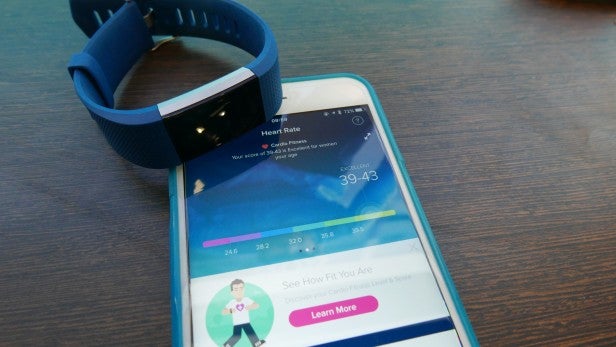
As for basic step-counting, the Fitbit Charge 2 appeared to be quite generous with steps, counter to what I found for distance. It averaged around 500 steps more per day than the Jawbone UP3, and around 800 more than a Samsung Gear S2.
All manufacturers use slightly different algorithms for detecting actual steps and to make sure it’s not just you flailing your arms around. So it’s more about consistency, and in this regard the difference between trackers was at least generally the same between days.
I was told by a Fitbit ambassador that the Charge 2 actually uses a barometric sensor to calculate its steps by tracking changes in pressure. That’s an interesting approach of which I wasn’t aware, and also explains the lack of true waterproofing; there’s a small hole for the sensor on the underside of the tracker.
The Charge 2 has been improved over the original in that there are now move alerts. Since the release of the original, move alerts have become a basic inclusion with rival trackers, so I’m pleased to see its presence.
The Charge 2 will detect when you’ve been idle during a set time window – say, your working hours when you’re sat at a desk – and then provide a vibration to tell you to get up and take a walk. This will happen 10 minutes before the hour if you’ve not taken 250 steps in the past 60 minutes. You’ll receive a motivational message on the display, too, and it’s a surprisingly handy prompt.
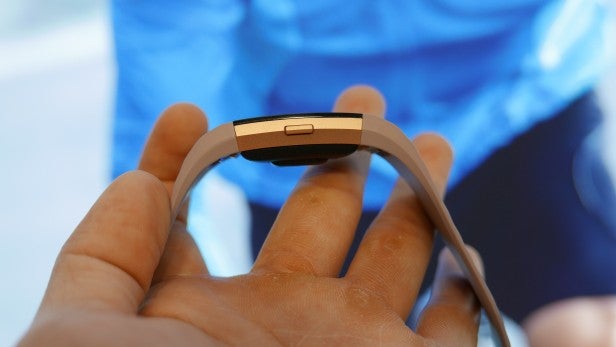
Alongside the 3-axis accelerometer there’s also an altimeter, so you get a record of the number of floors you’ve climbed. It’s a small touch, but one that can prompt you to take the stairs in lieu of the lift more often. When motivation is what makes or breaks an activity tracker, it’s the little things that add up.
As for the PurePulse optical heart rate tracker on the rear of the device, I tested this against the Wahoo Fitness Tickr X chest-based HRM and the wrist-based optical HRM from a TomTom Spark 3. Pre-run, the Charge 2 initially put my heart rate around 10 BPM above both the Tickr X and TomTom Spark 3.
Post-run, this was the case as well. The Charge 2 gave me a 144 BPM read out versus 134 BPM and 135 BPM from the Tickr X and Spark 3, respectively. Strangely, the Charge 2’s heart rate reading then plummeted briefly to 60 BPM, while I assume it struggled to get a proper reading before eventually finding it again. At this point, all three heart rate monitors levelled out at a 120 BPM post-run reading.
Fitbit says that “like all heart rate tracking technologies, accuracy is affected by physiology, location of device and different movements”. I mentioned earlier that the Charge 2 is available in different sizes. I was initially sent a large size, which, while not ridiculously loose, wasn’t quite as tight as I’d have liked – even on the smallest hole. I have very slender wrists. To protect my ego I’ll say that I can still bench two plates even with this disadvantage.
Fitbit replaced my strap for a smaller model and this improved the heart rate reading while running, since this is where you’ll want a snugger fit. It meant that on my second set of test runs, there was less difference between the two laps I ran. Still, the Charge 2 was basically as prone to deviations as I’ve come to expect from most optical HRMs, where they typically struggle with continuous readings during intense exercise. Typically, a chest-worn HRM will have a greater sampling rate, meaning it takes readings at much shorter intervals for accuracy.
Related: Workout logs are the key to getting fitter – here’s why
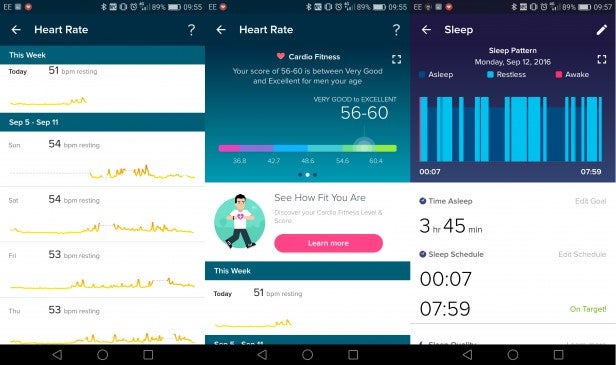
The Charge 2 does better taking resting heart rate measurements throughout the day and while you sleep, and this has always been a good indication of your cardiovascular health. It’s a metric you can track over time, so as you aim to become fitter, you can track your resting heart rate decreasing as your cardiovascular system works more efficiently.
I’ve now been using the Fitbit Charge 2 for a few months, and being able to see how my resting heart rate has changed based on my training programme is a useful insight. I’ve (intentionally) put on some weight in a bid to pack on more muscle, but as a side effect, I can see that my resting heart rate has increased from around 54 BPM to around 58-59 BPM. It shows to me that I should perhaps think about increasing my supplementary cardiovascular training.
You can also use the optical HRM for other exercise activities such as weightlifting or cycling, which you can trigger from the tracker itself. The results page is broken down into Heart Rate, Calories and Impact tabs. The Charge 2 told me that an hour-long weights session kept me in the “Fat Burn” zone throughout, burning 426 calories, and also contributed 1,616 steps to my day.
New with the Charge 2 is a VO2 max approximation to provide what Fitbit is calling your “Cardio Fitness” level. This is the maximum amount of oxygen your body uses during intense exercise and is another good indicator of your overall cardiovascular health. Fitbit calculates this by comparing your personal data against your running speed while using connected GPS and your heart rate measurements. Your score is provided against other people from your gender and age.
I actually found my Cardio Fitness score became slightly worse after my initial test run. This was most likely due to the anomalous heart rate readings that put it higher, and therefore more inefficient, than what the other HRM sensors I wore were reporting. The second lap in particular was quite a bit off.
Related: What is VO2 Max?
Without accurate continuous heart rate tracking, the Cardio Fitness score won’t be as accurate. The second set of test runs, with the tighter strap, provided more accurate results and put my Cardio Fitness score back above 60. I’m proud to say that this puts me at “Excellent” for my gender and age. It won’t ever be as accurate as a true VO2 Max test, but in fairness, a proper VO2 test is a far more complicated and expensive process that wouldn’t be available to many.
It isn’t all about intense exercise, though. A Breathe mode takes you through guided breathing exercises. A circle pulsates on the screen to show when to inhale and exhale, and you can choose different durations. It uses your heart rate and adjusts itself accordingly to get you in a more relaxed state. There are two- and five-minute durations. Mildly annoyingly, there’s no way of cancelling one mid-way, so if you start one you’re going to need to follow through.
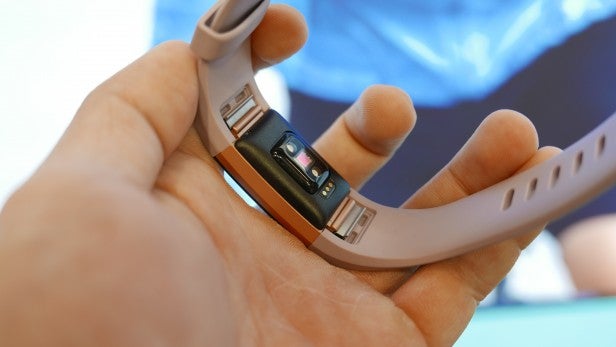
This feature isn’t drastically different to what you’ll see in the forthcoming watchOS 3 update for the Apple Watch although the implementation on the Apple Watch is more elegant. The Apple Watch uses haptic feedback to help you time your breathing, whereas you need to stare at the Fitbit Charge 2’s screen. How useful you’ll find the Breathe mode remains to be seen – we all know how to breathe, after all – but it could be a nice primer to just take it easy every now and then.
The Charge 2’s sleep tracking is an interesting one. It gives you a time “asleep”, which is the time you spent “awake” and “restless”, subtracted from your overall tracked sleeping time. It means that while you might have “slept” for eight hours, the “time asleep” reading on the dashboard might only read 2hrs 42mins. It’s worth keeping this in mind before assuming that the device isn’t tracking your sleep correctly.
I think this is actually a better, and less misleading, measurement than the overall “sleeping time” that other trackers and sports watches offer. It can show you why, even though you’re getting your target hours of sleep, you’re waking up fatigued and weary come morning. Really it’s the quality of asleep alongside duration that’s important for appropriate recovery and well-being.
In my case, with the sleep graph produced by the Charge 2, everything lined up as expected. This included the times I’m woken by the neighbourhood urban foxes who sit in the middle of the road and yelp incessantly for absolutely no reason.


